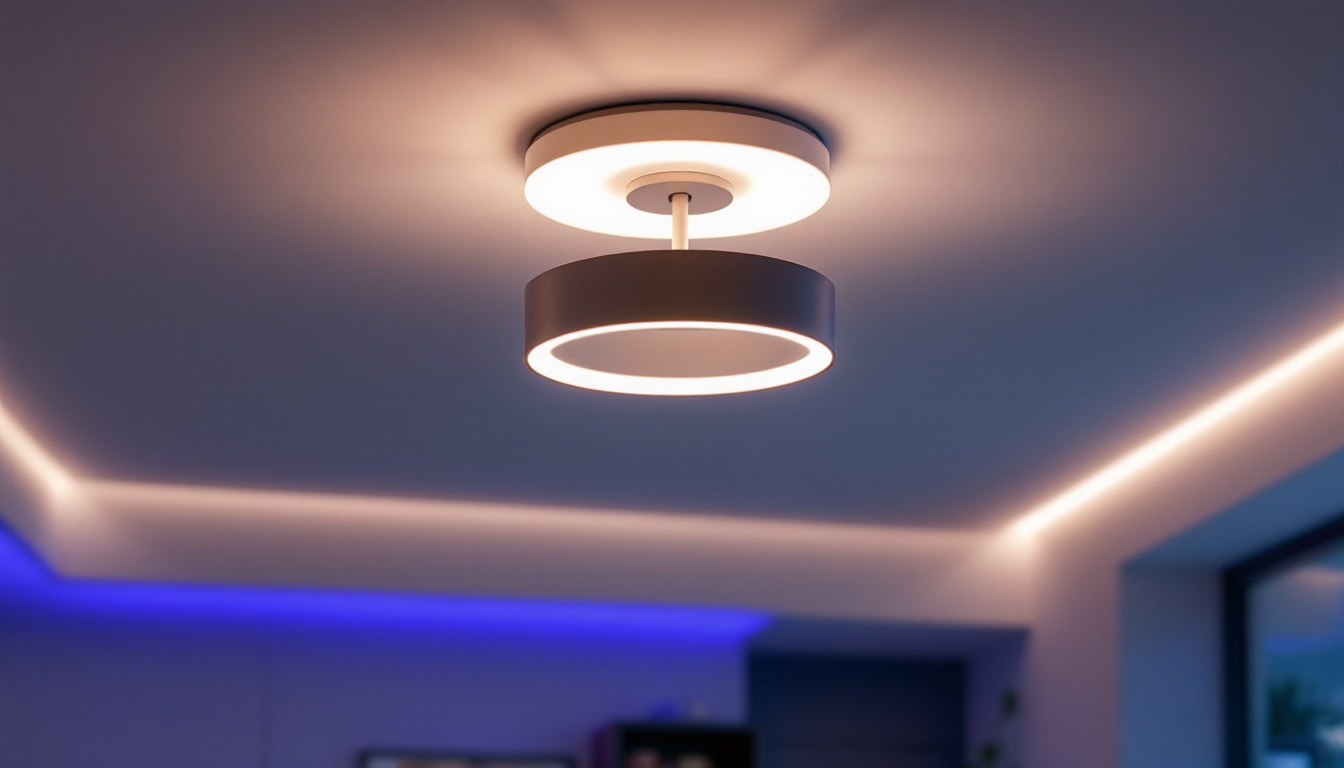

In the world of lighting design, the choice of fixtures can significantly influence both the aesthetics and functionality of a space. Among the various options available, the 40” ceiling light stands out as a versatile and effective solution for a multitude of applications. This guide aims to provide lighting contractors with essential insights into the selection, installation, and maintenance of 40” ceiling lights, ensuring that projects not only meet client expectations but also adhere to industry standards.
The 40” ceiling light is a popular choice for both residential and commercial spaces due to its balanced size, which makes it suitable for various room dimensions. Typically, this fixture can accommodate a range of bulb types, including LED, fluorescent, and incandescent, providing flexibility in terms of brightness and energy efficiency.
One of the key advantages of the 40” ceiling light is its design versatility. Available in a variety of styles—from modern to traditional—these fixtures can enhance the overall aesthetic of a room. Whether installed in a dining area, living room, or office, the right 40” ceiling light can serve as a focal point or blend seamlessly with existing decor.
Contractors should consider the specific design elements of the space when recommending a 40” ceiling light. For instance, a minimalist design may suit contemporary interiors, while a more ornate fixture could complement classic styles. Understanding the client’s vision is crucial in making the right choice. Furthermore, the finish of the fixture—whether it be brushed nickel, matte black, or antique brass—can significantly influence the room’s overall feel, allowing for personalization that reflects individual tastes and preferences.
The effectiveness of a ceiling light is largely determined by its ability to distribute light evenly across a space. A 40” ceiling light typically offers a broad beam angle, making it ideal for illuminating larger areas without creating harsh shadows. This is particularly important in settings such as kitchens and workshops, where visibility is paramount.
When selecting bulbs for a 40” ceiling light, contractors should consider the lumen output and color temperature. Brightness is measured in lumens, and a higher lumen count generally indicates a brighter light. Additionally, the color temperature, measured in Kelvin, affects the ambiance of the space—warmer tones (2700K-3000K) create a cozy atmosphere, while cooler tones (4000K-5000K) promote alertness and focus. It’s also worth noting that dimmable options are available, allowing users to adjust the brightness according to the time of day or specific activities, enhancing both functionality and comfort in the environment.
Moreover, the installation height of the 40” ceiling light can influence its effectiveness. In rooms with higher ceilings, the light may need to be supplemented with additional fixtures or strategically placed lamps to ensure adequate illumination. Conversely, in lower-ceilinged spaces, the 40” fixture can create an illusion of height while providing ample light. This adaptability makes it a favored choice among interior designers and homeowners alike, as it can be tailored to meet the unique requirements of any space.
Proper installation of a 40” ceiling light is essential for ensuring safety, functionality, and longevity. Contractors must adhere to local electrical codes and best practices to avoid potential hazards and ensure optimal performance.
Before installation, it is crucial to assess the existing electrical wiring. Ensure that the circuit can handle the load of the new fixture and that all connections are secure. Contractors should also consider the placement of the light fixture in relation to other electrical components, such as switches and outlets, to ensure ease of use.
Safety should always be a priority during installation. This includes turning off the power at the circuit breaker, using appropriate personal protective equipment, and ensuring that the fixture is securely mounted to prevent any risk of falling. Following these guidelines will help avoid accidents and ensure a successful installation.
Moreover, it is advisable to use a voltage tester to confirm that the power is indeed off before beginning any work. This simple step can prevent electrical shocks and ensure that the installation process is as safe as possible. Additionally, ensuring that the light fixture is compatible with the existing dimmer switches, if applicable, can enhance functionality and provide a more versatile lighting experience.
40” ceiling lights can be mounted in various ways, depending on the design of the fixture and the ceiling type. flush mounts are ideal for low ceilings, while pendant options may be better suited for higher ceilings, allowing for a more dramatic effect. Contractors should evaluate the ceiling height and room layout to determine the most suitable mounting option.
Additionally, it is important to consider the fixture’s weight when selecting mounting hardware. Heavy fixtures may require additional support, such as a ceiling brace, to ensure stability and safety. Proper mounting techniques will not only enhance the fixture’s appearance but also prolong its lifespan.
Furthermore, the choice of mounting can significantly influence the ambiance of the room. For instance, a chandelier-style fixture can create a focal point in a dining area, while a sleek, modern flush mount can provide a clean and unobtrusive look in a contemporary living space. Contractors should also take into account the light distribution and how it interacts with the room’s decor, as this can greatly affect the overall aesthetic and functionality of the space.
With growing awareness of environmental issues, energy efficiency has become a significant consideration in lighting design. The choice of a 40” ceiling light can greatly influence a building’s overall energy consumption. As more individuals and businesses strive to reduce their carbon footprint, the integration of energy-efficient lighting solutions has emerged as a critical component of sustainable architecture. This shift not only contributes to a healthier planet but also aligns with the increasing demand for cost-effective energy solutions.
LED bulbs are increasingly favored for their energy efficiency and longevity. Compared to traditional incandescent bulbs, LEDs consume significantly less energy and have a much longer lifespan, resulting in reduced maintenance and replacement costs. When recommending bulbs for a 40” ceiling light, contractors should highlight the benefits of LED options to clients. Furthermore, the technology behind LED lighting has advanced rapidly, leading to a broader range of color temperatures and styles, allowing homeowners to customize their spaces while still prioritizing energy savings.
Additionally, many LED bulbs offer dimming capabilities, allowing for greater control over light levels and further enhancing energy savings. Encouraging clients to invest in dimmable fixtures can lead to improved comfort and reduced energy bills over time. It’s also worth noting that the initial investment in LED technology is often offset by the long-term savings on electricity bills, making it a financially sound choice for both residential and commercial properties.
Contractors can also adopt sustainable practices during the installation process. This includes minimizing waste by properly measuring and cutting materials, recycling old fixtures, and using eco-friendly products whenever possible. By promoting sustainability, contractors can appeal to environmentally conscious clients and differentiate themselves in a competitive market. Moreover, implementing energy-efficient installation techniques, such as using smart lighting controls and occupancy sensors, not only enhances the functionality of the lighting system but also contributes to a more sustainable living environment.
In addition to these practices, contractors can educate clients about the importance of regular maintenance to ensure that their lighting systems operate at peak efficiency. Simple actions, such as cleaning fixtures and replacing filters in air handling systems, can significantly extend the life of lighting installations and maintain optimal energy performance. By fostering a culture of sustainability and energy efficiency, contractors not only enhance their reputation but also contribute to a larger movement towards environmentally responsible building practices.
Regular maintenance is key to ensuring the longevity and performance of 40” ceiling lights. Contractors should educate clients on proper care and troubleshooting techniques to address common issues that may arise.
Dust and debris can accumulate on light fixtures, diminishing their brightness and overall appearance. Regular cleaning is essential, particularly in high-traffic areas such as kitchens and living rooms. Contractors should recommend using a soft, damp cloth to gently wipe down the fixture and avoid harsh chemicals that could damage the finish.
In addition to cleaning, it is important to check the bulbs periodically. Replacing burnt-out bulbs promptly will ensure consistent lighting and prevent strain on the remaining bulbs. Contractors can provide clients with a simple maintenance schedule to help them keep their fixtures in optimal condition.
Despite proper installation and maintenance, issues may still arise with 40” ceiling lights. Common problems include flickering lights, uneven brightness, or complete failure to illuminate. Contractors should be prepared to troubleshoot these issues effectively.
Flickering lights can often be attributed to loose connections or incompatible bulbs. Checking the wiring and ensuring that the bulbs are securely seated can resolve this issue. If uneven brightness is observed, it may be due to a faulty bulb or a need for a higher lumen output. In cases where the fixture fails to illuminate altogether, checking the circuit breaker and ensuring power is reaching the fixture is essential.
The 40” ceiling light is a versatile and effective lighting solution that can enhance the functionality and aesthetics of any space. For lighting contractors, understanding the nuances of design, installation, energy efficiency, and maintenance is crucial in delivering high-quality service to clients. By staying informed about the latest trends and technologies in lighting, contractors can ensure that they meet the evolving needs of their customers while promoting safety, sustainability, and satisfaction.
Ultimately, the success of a lighting project hinges on the contractor’s ability to provide expert guidance and support throughout the process. By mastering the intricacies of the 40” ceiling light, contractors can position themselves as trusted professionals in the field, ready to tackle any challenge that comes their way.
Ready to elevate your lighting projects with the best 40” ceiling lights on the market? Look no further than LumenWholesale, where we offer contractors an unbeatable combination of quality, affordability, and convenience. Our spec-grade lighting products are designed to meet the highest industry standards, ensuring you deliver reliable and high-performance lighting solutions to your clients. Take advantage of our wholesale prices, free shipping on bulk orders, and a vast selection that cuts out the middleman costs. Make your next project shine with LumenWholesale, where you can find Wholesale Lighting at the Best Value.

Discover how incorporating an outdoor cable splicer can elevate your lighting contracting business.

Discover how Light Head Light Head technology revolutionizes lighting installation projects by enhancing efficiency, precision, and design flexibility.

Discover essential insights into the world of lightbulbs tailored for lighting contractors.

Discover why purchasing decorative LED bulbs in bulk from local distributors might not be the best choice.
Get notified when NEW deals are released.
Optimize your budget with wholesale discounts.
Only top-quality, specification-grade lighting products.
No additional costs at checkout - what you see is what you pay.
We understand the unique needs of contractors.